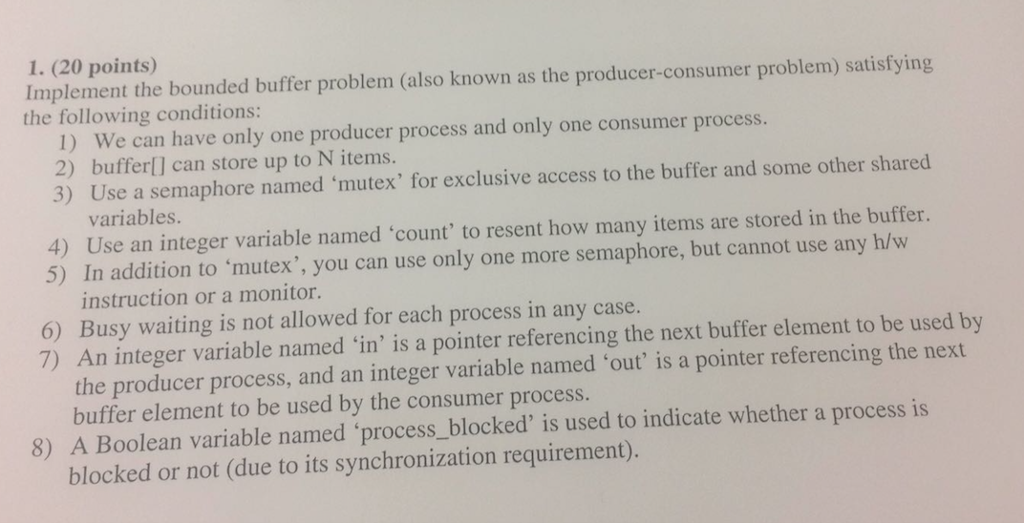

- #PRODUCER CONSUMER WITH BOUNDED BUFFER BINARY SEMAPHOR HOW TO#
- #PRODUCER CONSUMER WITH BOUNDED BUFFER BINARY SEMAPHOR CODE#
The producer and consumer processes were separate and were sharing the buffer. So the buffer should only be accessed by the producer or consumer at a time. I had implemented the Bounded buffer (Buffer size 5) problem using three semaphores, two counting (with count MAX 5) and one binary semaphore for critical section. In this project, you will design a programming solution to the bounded-buffer problem using the producer and consumer processes shown in Figures 5.9 7.1 and 5.10 7.2. Semaphore primitives P and V (works for binary and counting sems). The consumer removes the items from the buffer and consumes them.Ī producer should not produce items into the buffer when the consumer is consuming an item from the buffer and vice versa. In Section 5.7.1 7.1.1, we presented a semaphore-based solution to the producer consumer problem using a bounded buffer. There is a fixed size buffer and the producer produces items and enters them into the buffer. Moi python $ python boundedbuffer_semaphore.The producer consumer problem is a synchronization problem. Print("'".format(buf, buf, consumer_idx)) Producer_idx = (producer_idx + 1) % buf_size Global producer_idx, counter, buf, buf_size Raise ValueError('Result size is %d instead of %d' % (len(result), value_count)) Here's a small test program I used to play around: def producer(queue, start, end, step):ĭef consumer(queue, count, result, lock): Self.read_index = (self.read_index + 1) % len(self.buff)

Self.write_index = (self.write_index + 1) % len(self.buff) Also, I think you could access the buffer without holding the locks (because lists themselves are thread-safe): def put(self, val): I would remove the size attribute in favor of len(self.buff) though and rename the start and end indices to read_index and write_index respectively (and the locks as well). ( CPython's queue implementation does this.) You could remove one of the locks and use it in both get and put to protect both the start and the end index which wouldn't allow consumers and producers to access the queue simultaneously. Binary semaphore integer value can range only between 0 and 1. Producer-consumer with bounded buffer 6. P waits until value is 1, then sets it to 0 V sets value to 1, waking up a waiting P if any 5.
#PRODUCER CONSUMER WITH BOUNDED BUFFER BINARY SEMAPHOR CODE#
Whenever a process wants to get access to the mutex it can aquire the semaphore. binary semaphore instead of an integer value, has a boolean value. Binary semaphores are used to protect the critical sections within the code - those sections where both the producer and the consumer manipulate the same data structure. The two semaphores are definitely necessary. consumer-producer problem that fills all the buffers. A binary semaphore is a way to enforce mutual exclusion. A Binary semaphore - integer value can range only between 0. The semaphores prevent concurrent producers and consumers from writing and reading too much and the locks prevent concurrent producers or consumers from modifying the end or start indices simultaneously. consumer-producer problem that fills all the buffer slots. Is this implementation bug-free? Could this be simplified further to use fewer mutexes/semaphores? Self.closed = Semaphore(size) # block till there's item to consumeįor _ in range(size): # initialize with all closed acquired so that consumer is blocked Self.open = Semaphore(size) # block till there's space to produce Self.start_lock = Lock() # protect start from race across multiple consumers Self.end_lock = Lock() # protect end from race across multiple producers
#PRODUCER CONSUMER WITH BOUNDED BUFFER BINARY SEMAPHOR HOW TO#
I'm trying to understand how to implement a Queue with a bounded buffer size that can be used by multiple producers and consumers using Python Semaphores.


 0 kommentar(er)
0 kommentar(er)
